Related Research Articles

Approximately 251.9 million years ago, the Permian–Triassicextinction event forms the boundary between the Permian and Triassic geologic periods, and with them the Paleozoic and Mesozoic eras. It is Earth's most severe known extinction event, with the extinction of 57% of biological families, 83% of genera, 81% of marine species and 70% of terrestrial vertebrate species. It is also the greatest known mass extinction of insects. It is the greatest of the "Big Five" mass extinctions of the Phanerozoic. There is evidence for one to three distinct pulses, or phases, of extinction.

Tabulata, commonly known as tabulate corals, are an order of extinct forms of coral. They are almost always colonial, forming colonies of individual hexagonal cells known as corallites defined by a skeleton of calcite, similar in appearance to a honeycomb. Adjacent cells are joined by small pores. Their distinguishing feature is their well-developed horizontal internal partitions (tabulae) within each cell, but reduced or absent vertical internal partitions. They are usually smaller than rugose corals, but vary considerably in shape, from flat to conical to spherical.
The Late Triassic is the third and final epoch of the Triassic Period in the geologic time scale, spanning the time between 237 Ma and 201.4 Ma. It is preceded by the Middle Triassic Epoch and followed by the Early Jurassic Epoch. The corresponding series of rock beds is known as the Upper Triassic. The Late Triassic is divided into the Carnian, Norian and Rhaetian ages.
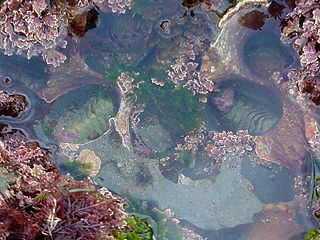
The Mesozoic marine revolution (MMR) refers to the increase in shell-crushing (durophagous) and boring predation in benthic organisms throughout the Mesozoic era, along with bulldozing and sediment remodelling in marine habitats. The term was first coined by Geerat J. Vermeij, who based his work on that of Steven M. Stanley. While the MMR was initially restricted to the Cretaceous, more recent studies have suggested that the beginning of this ecological arms race extends as far back as the Triassic, with the MMR now being considered to have started in the Anisian or the Aalenian. It is an important transition between the Palaeozoic evolutionary fauna and the Modern evolutionary fauna that occurred throughout the Mesozoic.
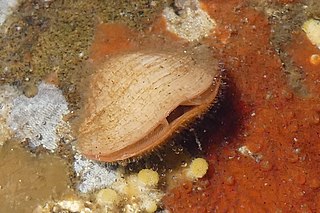
Brachiopods, phylum Brachiopoda, are a phylum of trochozoan animals that have hard "valves" (shells) on the upper and lower surfaces, unlike the left and right arrangement in bivalve molluscs. Brachiopod valves are hinged at the rear end, while the front can be opened for feeding or closed for protection. Two major categories are traditionally recognized, articulate and inarticulate brachiopods. The word "articulate" is used to describe the tooth-and-groove structures of the valve-hinge which is present in the articulate group, and absent from the inarticulate group. This is the leading diagnostic skeletal feature, by which the two main groups can be readily distinguished as fossils. Articulate brachiopods have toothed hinges and simple, vertically oriented opening and closing muscles. Conversely, inarticulate brachiopods have weak, untoothed hinges and a more complex system of vertical and oblique (diagonal) muscles used to keep the two valves aligned. In many brachiopods, a stalk-like pedicle projects from an opening near the hinge of one of the valves, known as the pedicle or ventral valve. The pedicle, when present, keeps the animal anchored to the seabed but clear of sediment which would obstruct the opening.

Claraia is an extinct genus of scallop-like bivalve molluscs that lived from the Capitanian stage of the Middle Permian to the Anisian stage of the Middle Triassic, 266-237 million years ago. Fossils have been found worldwide in North America, Europe, Asia, Africa, and Australia. These are common fossils subsequent to the Permian-Triassic boundary, suggesting that the genus experienced rapid diversification during and after the Permian–Triassic extinction event, around 251.9 million years ago, making it a Disaster taxon

Rhynchonelliformea is a major subphylum and clade of brachiopods. It is roughly equivalent to the former class Articulata, which was used previously in brachiopod taxonomy up until the 1990s. These so-called articulated brachiopods have many anatomical differences relative to "inarticulate" brachiopods of the subphyla Linguliformea and Craniformea. Articulates have hard calcium carbonate shells with tongue-and-groove hinge articulations and separate sets of simple opening and closing muscles.
Gosaukammerella is a genus of strophomenid brachiopods, with one species Gosaukammerella eomesozoica. It was originally thought to be a problematic calcareous alga, and described under the name Pycnoporidium eomesozoicum.
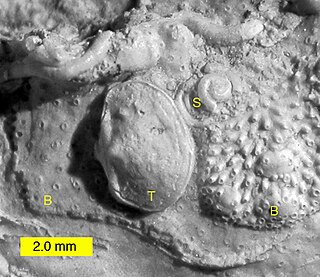
Thecideida is an order of cryptic articulate brachiopods characterized by their small size and habit of cementing their ventral valves to hard substrates such as shells, rocks and carbonate hardgrounds. Thecideides first appeared in the Triassic and are common today.

Athyridida is an order of Paleozoic brachiopods included in the Rhynchonellata, which makes up part of the articulate brachiopods.
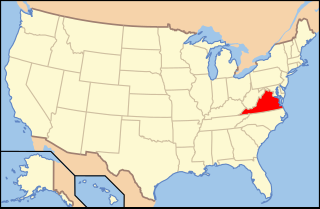
Paleontology in Virginia refers to paleontological research occurring within or conducted by people from the U.S. state of Virginia. The geologic column in Virginia spans from the Cambrian to the Quaternary. During the early part of the Paleozoic, Virginia was covered by a warm shallow sea. This sea would come to be inhabited by creatures like brachiopods, bryozoans, corals, and nautiloids. The state was briefly out of the sea during the Ordovician, but by the Silurian it was once again submerged. During this second period of inundation the state was home to brachiopods, trilobites and entire reef systems. During the mid-to-late Carboniferous the state gradually became a swampy environment.
The Luning Formation is a geologic formation in Nevada. It preserves fossils dating back to the Triassic period. The lowermost strata dates to the late Carnian-early Norian boundary.

Rhaetina is an extinct genus of brachiopods belonging to the family Angustothyrididae.

Strophomenata is an extinct class of brachiopods in the subphylum Rhynchonelliformea.
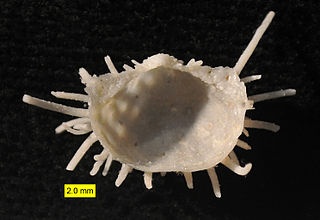
Productida is an extinct order of brachiopods in the extinct class Strophomenata. Members of Productida first appeared during the Silurian. They represented the most abundant group of brachiopods during the Permian period, accounting for 45-70% of all species. The vast majority of species went extinct during the Permian-Triassic extinction event, though a handful survived into the Early Triassic. Many productids are covered in hollow tubular spines, which are characteristic of the group. A number of functions for the spines have been proposed, including as a defensive mechanism against predators.
Cubanothyris is an extinct genus of prehistoric brachiopods in the extinct family Angustothyrididae. Species are from the Triassic of China, the Russian Federation and Tajikistan. The type species, C. elegans, is found only at River Kuna.
Crurithyris is an extinct genus of brachiopod belonging to the order Spiriferida and family Ambocoeliidae.
Mesolobus is an extinct genus of brachiopod belonging to the order Productida and family Rugosochonetidae.
Schizophoria is an extinct genus of brachiopod belonging to the superfamily Enteletoidea. Specimens have been found in Devonian through Permian beds in North America, Australia, central and southeast Asia, and eastern Europe.

Marginifera is an extinct genus of brachiopod belonging to the order Productida. Specimens have been found in Carboniferous to Triassic beds in Asia, Europe, Madagascar, and North America.